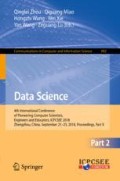Abstract
Term is the linguistic expression of the concepts in professional knowledge, which are accumulated through incremental exploration and research in specific fields. In the study of intelligence analysis and knowledge organization, term extraction is an important research subject. Deep neural network is an algorithm based on machine learning. It aims to obtain high-level features that can better represent raw data through learning by multilayer structure. Though machine learning has been widely used in studies in many fields, it is rarely mentioned in term extraction. The paper combines traditional method of extraction term with the new method of machine learning that is deep neural network. And it uses the method to extract terms from the real and effective corpus for experiments. Compared with methods based solely on language rules, language rules & statistical calculation, this method can improve the accuracy rate by about 47% and 8% respectively. This method gets some new terms that are not contained in the thesaurus. It verifies the effectiveness of machine learning in term extraction.
Access this chapter
Tax calculation will be finalised at checkout
Purchases are for personal use only
References
Jinsong, Y.: A Survey of terminology automatic extraction methods. Comput. Sci. 42(8), 7–12 (2015)
Heylen, K., Dehertog, D.: Automatic Term Extraction. John Benjamins Publishing Company, Amsterdam (2014)
Frantzi, K., Ananiadou, S., Mima, H.: Automatic recognition of multi-word terms: the C-value/NC-value method. Int. J. Digit. Libr. 3(2), 115–130 (2000)
Astrakhantsev, N.A., Fedorenko, D.G., Turdakov, D.Y.: Methods for automatic term recognition in domain-specific text collections: a survey. Program. Comput. Softw. 41(6), 336–349 (2015)
Lossio-Ventura, J.A., Jonquet, C., Roche, M., Teisseire, M.: Yet another ranking function for automatic multiword term extraction. In: Przepiórkowski, A., Ogrodniczuk, M. (eds.) NLP 2014. LNCS (LNAI), vol. 8686, pp. 52–64. Springer, Cham (2014). https://doi.org/10.1007/978-3-319-10888-9_6
LossioVentura, J.A., Jonquet, C., Roche, M.: Biomedical term extraction: overview and a new methodology. Inf. Retr. J. 19(1), 59–99 (2016)
Wen, Z.: The exploration of information extraction and analysis about science and technology policy in China. Electron. Libr. 35(4), 709–723 (2017)
Lecun, Y., Bengio, Y., Hinton, G.: Deep learning. Nature 521(7553), 436–444 (2015)
Lecun, Y., Kavukcuoglu, K., Farabet, C.: Convolutional networks and applications in vision. In: IEEE International Symposium on Circuits and Systems, pp. 253–256. IEEE, New York (2010)
Leng, J., Jiang, P.: A deep learning approach for relationship extraction from interaction context in social manufacturing paradigm. Knowl. Based Syst. 100, 188–199 (2016)
Glorot, X., Bordes, A., Bengio, Y.: Domain adaptation for large-scale sentiment classification: a deep learning approach. In: International Conference on Machine Learning, pp. 513–520. Omni Press, Bellevue (2011)
Xue, F., Guodong, Z.: Deep learning for natural language processing. J. Autom. 42(10), 1445–1465 (2016)
Mikolov, T., Chen, K., Corrado, G.: Efficient estimation of word representations in vector space. Comput. Sci., 1–13 (2013)
Shui, L., Xi, C., Wenyan, G.: New progress in deep learning methods. J. Intell. Syst. 11(5), 567–577 (2016)
Acknowledgment
This research is supported by the National Social Science Fund Project: Research on Information Analysis Method and Integrated Platform Based on Fact-type Scientific and Technical Big Data. [grant number 14BTQ038].
Author information
Authors and Affiliations
Corresponding author
Editor information
Editors and Affiliations
Rights and permissions
Copyright information
© 2018 Springer Nature Singapore Pte Ltd.
About this paper
Cite this paper
Zeng, W., Li, X., Li, H. (2018). Study on Chinese Term Extraction Method Based on Machine Learning. In: Zhou, Q., Miao, Q., Wang, H., Xie, W., Wang, Y., Lu, Z. (eds) Data Science. ICPCSEE 2018. Communications in Computer and Information Science, vol 902. Springer, Singapore. https://doi.org/10.1007/978-981-13-2206-8_12
Download citation
DOI: https://doi.org/10.1007/978-981-13-2206-8_12
Published:
Publisher Name: Springer, Singapore
Print ISBN: 978-981-13-2205-1
Online ISBN: 978-981-13-2206-8
eBook Packages: Computer ScienceComputer Science (R0)

